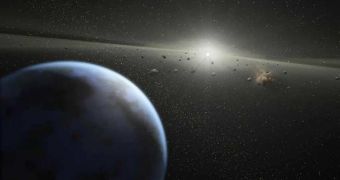Respected astronomer Frank Drake – the one who produced the famous equation of the same name – hypothesized more than 50 years ago that the Milky Way might be teeming with rocky exoplanets similar to our own. He made the prediction based purely on theoretical probabilities, and now new data of our galaxy seems to suggest he was correct. Recent investigations of destroyed stars called white dwarfs show that most of them at one point featured rocky exoplanets around them. Astronomers now say that hundreds, or even thousands, of civilizations may exist in the Milky Way alone.
White dwarfs are structures that remain after Sun-like stars reach the end of their burning cycle. As this happens, they begin to swell up into a red giant, as their hydrogen reserves are depleted. When this happens, the star can no longer sustain nuclear fusion, and violently sheds the outer layers of its atmosphere. What remains is a dim core that burns only helium fuel, and lasts for billions of years. It is believed that white dwarfs account for about 50 percent of all the hundreds of billions of stars in the Milky Way, and that their vast majority at one point or the other harbored rocky planets around them.
At this point, “wobble and blink” are the only two astronomical methods of detecting exoplanets. One revolves around detecting minute changes in the way a star moves (wobbles), while the other looks for changes in its apparent brightness that may be caused by an exoplanet moving between it and Earth. The methods are still rudimentary, in the sense that current technology does not really allow for smaller, Earth-like planets to be imagined directly. Most often, researchers find gas giants, similar in size and mass to Jupiter and Saturn.
But today, at the meeting of the Royal Astronomical Society, in Glasgow, the United Kingdom, experts will unveil a new statistical method of determining how many rocky exoplanets the size of Earth may exist in the Milky Way. The researchers say that their investigation revolved around studying the thin, rare atmosphere that white dwarfs have around them, which very frequently reveals the spectrometric signature of rocky material. This is in tune with the prediction that a red giant would engulf exoplanets too close to them, destroying them completely.
Since the team estimates that about 3.5 percent of all Sun-like stars in the galaxy have rocky exoplanets around them, this could mean that, in the past, the Milky Way may have harbored as much as a billion such exoplanets at the same time. Other analysts say that the 2.5 percent value is too conservative, and that the number of planets is probably larger, ScienceNow reports.

 14 DAY TRIAL //
14 DAY TRIAL //